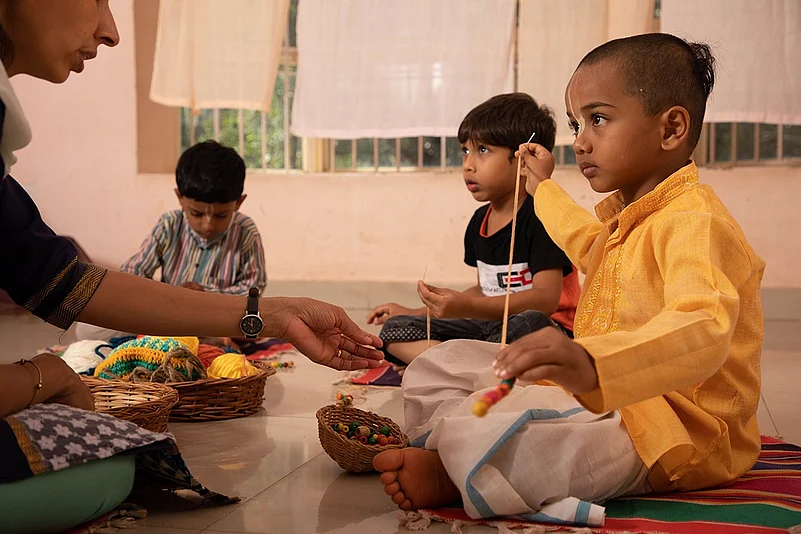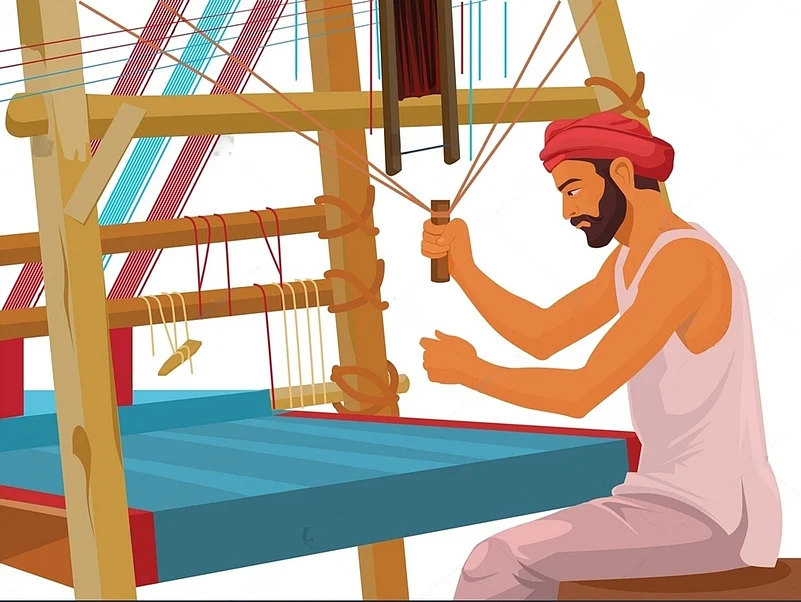When 60-year-old Malipeddi Bhagyawati sat down to spin as part of a lecture-demonstration on Patnulu khadi in a Bengaluru school, she wasn’t expecting the level of knowledge the young students had. To her surprise, the teenagers not only recognized the rare single spindle charkha but also knew the intricate processes of spinning, from ginning to carding. This rare awareness, among 20-odd students, reflects a growing interest among Gen Z in traditional handloom weaving.
This awareness comes at a critical time. Handloom weaving in India has been facing a steady decline due to a lack of informed clientele who appreciate the craftsmanship. Samyuktha Gorrepati, a textile designer from Hyderabad, who has been helping weavers build sustainable business enterprises, noted that this decline is tied to a missing link—understanding the skill and effort involved. “Traditionally, weavers cannot exist without spinners, and they both cannot exist without an informed clientele who could tell the difference between the output of a single spindle loom like the one used in Ponduru and, say, the ambar charkha,” said Gorrepati.
It is this informed generation, like the students at Vidyakshetra Gurukul in Kengeri, who may bring about the revival of handloom weaving. The school, which incorporates spinning and weaving into its curriculum, is fostering an early appreciation for sustainable practices. Sixteen-year-old Aradhika, a student at the school, has been spinning for nine years and considers it a life skill. “I think it's a life skill worth learning, like say, swimming. Learning to spin and weave means you get to make your own clothes,” she said. This hands-on experience not only deepens their understanding of traditional crafts but also helps them empathize with the struggles of artisans. “When I went to Ponduru last year, I realised what a struggle it is for weavers and spinners to make a decent living,” she added.

The awareness among these young students is beginning to spread beyond alternative education models. Gorrepati observed that even mainstream schools, like one in Yelahanka, are starting to show interest in sustainable practices. “Definitely, something is shifting in people about these things,” she said.
The shift is also supported by individuals outside formal education, like Mysuru-based artist K.L. Sachidananda. After discovering his passion for spinning seven years ago, he now goes to schools to teach children the joys of spinning, hoping it will turn the tide against fast fashion and mass consumption. “Maybe it is possible that the tide will turn against fast fashion and consumption, the endless greed that is destroying our society,” said Sachidananda. His workshops have inspired many, including 55-year-old Minakshi Prabhu from Bengaluru, who believes that spinning helps children focus and disconnect from digital devices. “The time spent away from all those devices will do them good,” Prabhu said.
For some of these young spinners, this traditional craft is more than just a hobby; it could become a career. Aradhika, after visiting Ponduru, realized her future might lie in weaving. “I want to be the change and be the 1 percent of the future generation that choose to weave or spin. Besides, spinning makes me happy,” she said.
A Generation Spins Hope for the Future of Handloom Weaving
The revival of traditional handloom weaving is a timely conversation, especially in the context of fast fashion's overwhelming dominance. What’s particularly encouraging is that it is being driven by young individuals whose curiosity and dedication to sustainable practices could very well become the foundation for the future of handloom in India.
The key to reviving handloom lies in education, as demonstrated by the students at Vidyakshetra Gurukul, who are learning the intricacies of spinning and weaving as part of their curriculum. By integrating traditional crafts into school education, we can cultivate a generation that not only understands the value of handwoven fabrics but also respects the labor that goes into their creation. Aradhika’s statement, “Learning to spin and weave means you get to make your own clothes,” highlights the empowerment and self-sufficiency that can come from learning these skills.
Moreover, this grassroots revival is not just about preserving cultural heritage; it’s also about ethical consumption. As textile designer Samyuktha Gorrepati pointed out, “Weavers cannot exist without spinners, and they both cannot exist without an informed clientele.” This statement encapsulates the essence of the problem—without an appreciation for the skill and effort required, handloom weaving cannot thrive. By fostering an understanding of the craft among young people, we are creating future consumers who will value quality and sustainability over mass production and fast fashion.
The enthusiasm of individuals like K.L. Sachidananda and Minakshi Prabhu further reinforce the belief that handloom weaving can make a comeback. Their work in educating children about spinning not only imparts a useful skill but also encourages mindfulness, focus, and a connection to tradition. Sachidananda's optimism, “Maybe it is possible that the tide will turn against fast fashion and consumption,” reflects the hope that the efforts of this new generation will bear fruit.
In a world increasingly dominated by machine-made, mass-produced products, the revival of handloom weaving represents a rebellion against unsustainable practices. It is a call to return to the roots of slow, thoughtful production and to support artisans who have been keeping these traditions alive for centuries. As this new generation takes up the spindle, there is hope that handloom weaving will not just survive but thrive in the years to come.
By reconnecting with age-old practices and fostering a deeper respect for craftsmanship, this generation has the potential to not only preserve cultural heritage but also inspire a more thoughtful, sustainable approach to fashion and production. The resurgence of handloom weaving could pave the way for a more conscious and connected world.
As this movement grows, it is clear that the revival of handloom weaving is not just about preserving tradition but also about reshaping future consumption patterns. By empowering young people with skills and knowledge, we are fostering a more responsible and sustainable generation. Their appreciation for the craftsmanship and effort behind handmade textiles could lead to a meaningful shift away from mass-produced goods, ensuring a lasting legacy for artisans and the environment alike.

















